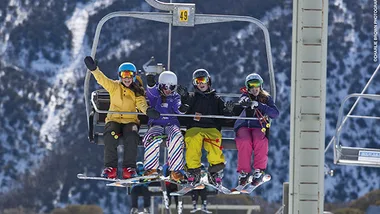Giving birth to a defenceless three kilogram fawn a footie field away from a pride of 19 lions could be considered risky. And yet, that’s exactly what a Grant’s gazelle did as we drove through the golden grasses of Tanzania’s Serengeti.
The lions were half asleep in a nearby creek after feasting on wildebeest and as they dozed in the shade of a thorn tree, clumsily swatting flies from their faces with their paws, a gazelle spent five seconds self-delivering her newborn.
Not even a tasty morsel such as a fawn could stir the well-fed lions. Even so, the mother’s sense of urgency, as she licked her fawn clean, was obvious. If any fawn is to survive, it must stand and take its first feed within an hour. A dozen other predators could easily discover its nursery in the grass.

A Grant’s gazelle and her newborn.
As the mother focused on our approaching vehicle, the rhythmic call of the “Go away” bird appeared to be ordering us to move on. “Go away … Go away … Go away,” it repeated petulantly.
After several nudges from Mum, the calf stood, wobbling as it did, before it fell headfirst, somersaulting onto its back, legs akimbo. Time and time again, the fawn attempted to stand and then another bird, the Cape turtle dove, joined in with its soft, insistent song that sounded exactly as if it was saying, “Work harder … work harder … work harder.”
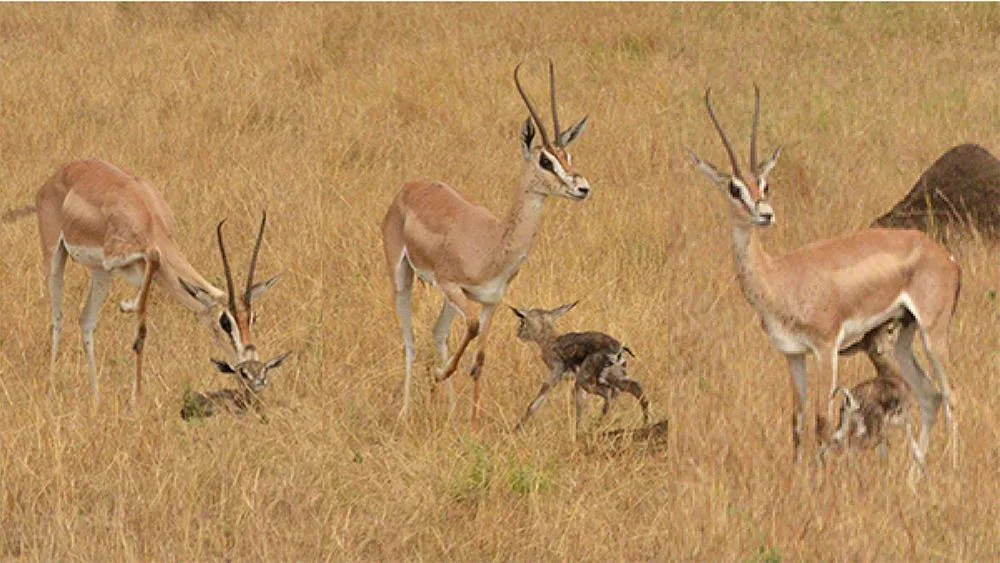
It took 19 minutes for this fawn to stand and feed.
Ten more attempts and 19 minutes later, the fawn took its first step. A minute later, it was suckling, tail wagging. Then, several “aunties” from the nearby herd joined Mum to greet the newborn in what looked like a “gazelle shower”. As our safari vehicle left the scene, the newborn was running circles around its “aunts”. The lions were still asleep without a care in the world.
Watching a birth is fascinating, but a safari is not for the faint-hearted: birth and death are close companions on the African savannah. A few months before our arrival, a cameraman witnessed a newborn gazelle being eaten alive by a male baboon, as its mother stood hopelessly by.
Of all the safari destinations in Africa, northern Tanzania offers prolific game and incredible scenery. The African Rift Valley, a 6000-kilometre long fault in the Earth’s crust, has created one of the most spectacular landscapes the continent has to offer. At the heart of the Serengeti is the Ngorongoro Crater, an old volcano that towers 2400 metres above the surrounding savannah.
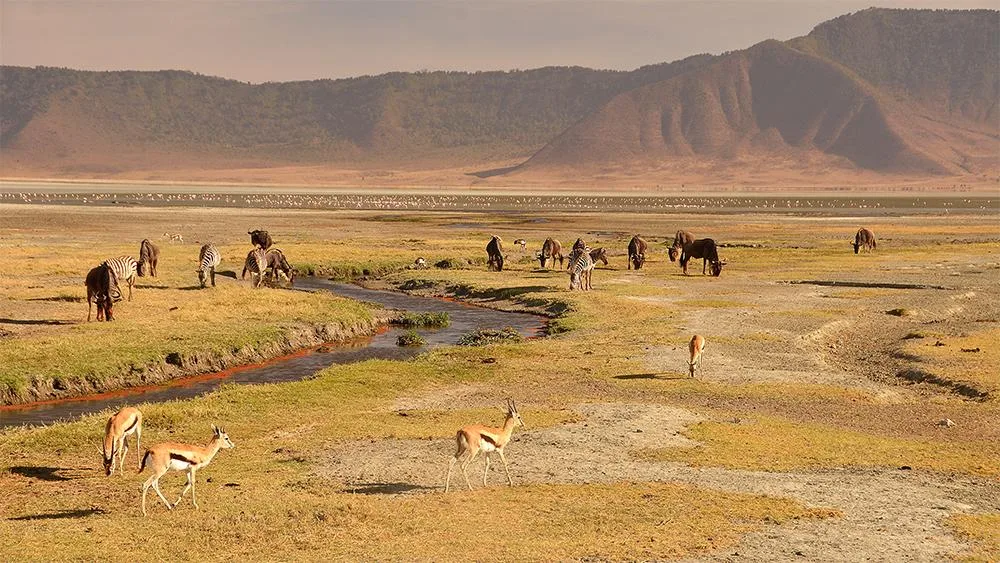
The Ngorongoro crater floor.
The Big Five (lion, leopard, elephant, rhino and buffalo) are found here, as are the Ugly Five (warthog, wildebeest, vulture, marabou stork and hyena). South of Ngorongoro is Lake Manyara, home to a million-plus flamingos. The day before our arrival, the flock decided to relocate from the bay next to our lodge to the other side of the lake – creating a thick pink line in the distance.
Sometimes your luck runs out, as it did for a flamingo when a tawny eagle dropped out of the sky. Talons outstretched, it grasped the flamingo’s back in a vice-like grip. “The corpse crumpled as the eagle lifted it into the sky,” said the father of the family, who witnessed the scene. “In the distance, you could make out the rest of the flock, strutting forward in formation, perfectly in time, like a corps de ballet in pink tutus.”
The next morning as the family was having breakfast on the deck of the lodge, a vervet monkey swung onto their table from a nearby tree and stole a croissant. In a second, the cheeky ash blond primate was back on a bough clutching its prize. This harmless foray initially startled everyone, but soon we were laughing, scanning the tree for more interlopers with our breakfast plates held close.
A male zebra at Lake Manyara seems unaware of our safari truck. Photo by ©Mike Dolan. On safari, the day starts at dawn as you set out in the morning chill to explore the local terrain. Wild animals don’t identify vehicles with humans and, as long you’re down wind, you get very close.
On safari, the day starts at dawn as you set out in the morning chill to explore the local terrain. Wild animals don’t identify vehicles with humans and, as long you’re down wind, you get very close.
“A truck must look a little like an elephant to most wild animals,” our guide told us. Unless you’re an elephant, I thought. It seems elephants are seldom disturbed by a truck, except if it’s a bull “in musth”, pronounced must. “In musth” is a polite way of saying a bull is looking for a mate, a preoccupation that makes them extremely irritable and intolerant. On the few occasions safari vehicles have been charged, a bull in musth has been responsible.
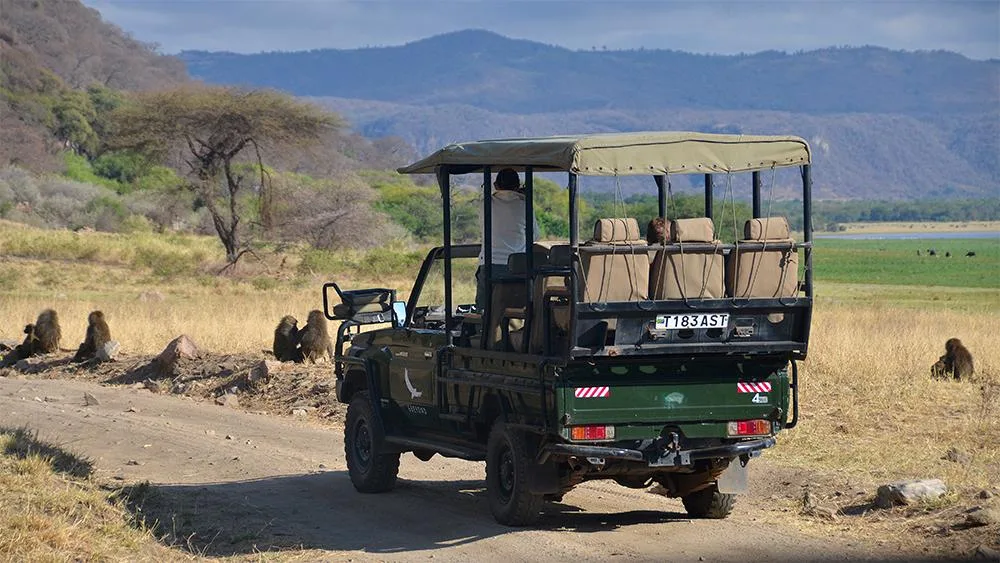
A troop of baboons and safari vehicle at Lake Manyara.
As it happened, it was an elephant day. On our return to the lodge for lunch, we passed a breeding herd of 120 mothers and calves, most of which preferred the road to the forest. There’s no argument about right of way and needless to say we were late for lunch.
Lake Manyara is one of the few places on this continent where lions, like leopards, take to the trees. Big cats are often seen draped like lotharios on the boughs of the most comfortable trees. These trees are part of a lush forest that thrives between the lakeshore and the Rift Valley escarpment, thanks to a series of fresh-water springs. It would be difficult to beat the game viewing here. It’s ringside seats for everyone with a magnificent scenic backdrop of mountains and the shimmering soda lake.
There is, however, only one place to stay in the national park and that’s the AndBeyond Lake Manyara Tree Lodge, where each bedroom suite is built in a towering tree. Imagine a timber platform with king-size bed, claw-foot bath and porcelain loo half way up a 30-metre mahogany tree, all elegantly wrapped in a secure shell of mosquito wire-netting and banana leaves. Forget the Tarzan vine, entry is by a sweeping wooden staircase.
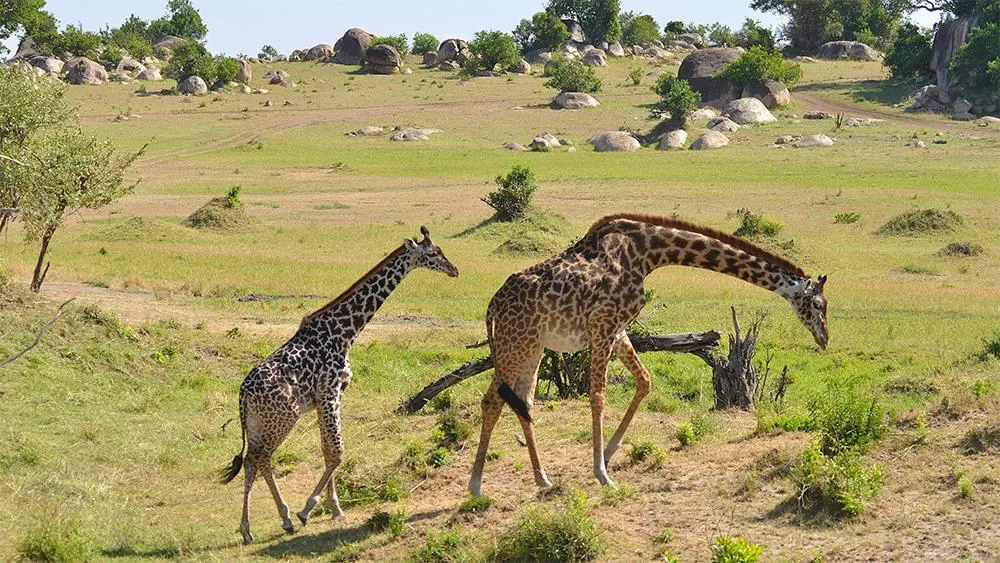
A mother giraffe and her foal on the Serengeti.
As it’s an open camp, there’s one strict rule: every guest needs an armed escort before dawn and after dusk when walking between their tree house and the main lodge. A Maasai tribesmen, armed with a spear, is provided for each guest. And he is not for show; your Maasai guide knows exactly what to do if you meet a lion. Rule number one is: don’t turn and run – by doing so you appear as prey. Rule number two is: don’t panic. Rule number three is: listen to his instructions. Follow the rules and you’re unlikely to miss dinner … or be dinner.

Maasai tribesman; Ngorongoro crater floor; and a vulture.
The Serengeti is an hour’s bumpy flight in an eight-seater Cesna Caravan over the Ngorongoro Crater towards the Maasai Mara on the Kenyan border. On arrival at the dirt airstrip, a pick-up truck was waiting. “You’ve missed the Great Migration,” said the driver so nonchalantly he could have been talking about the departure of the number 93 bus. “It took off days ago …”
The Great Migration is an annual event that sees two million wildebeest and other grazing animals go “walk-about”. Bizarrely, 10 minutes into our drive, we came across a herd of some 600 wildebeest. “Are these conscientious objectors?” I asked. The driver shrugged. Apparently, not all wildebeest enjoy the ultra-marathon.
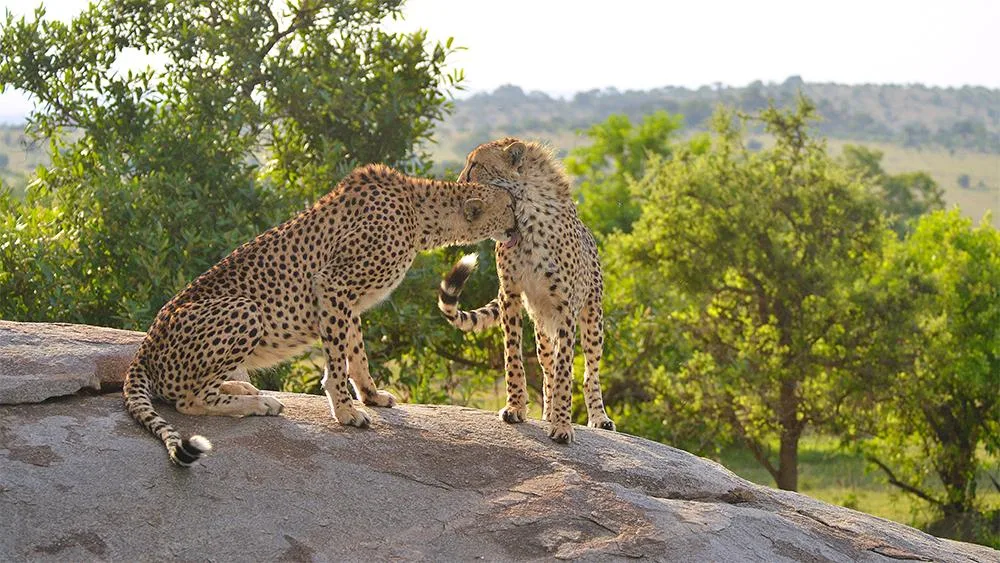
A cheetah mother (sitting) greets its sub-adult cub.
The Serengeti in northern Tanzania has rolling hills topped with smooth rounded boulders, some the size of houses. It was in the shadow of such a boulder, we spotted a cheetah family – a mother and her two sub-adult cubs, resting after the heat of the day. The mother was calling her cubs from their separate day beds, meowing softly like a domestic cat. As each cub arrived, it was greeted with numerous licks and nuzzles. In the distance, a large herd of giraffes looked a little like high-rise cranes.
Home on the Serengeti is usually under canvas – a temporary camp of well-appointed tents. The tents at our camp, AndBeyond Serengeti Under Canvas, had mini-chandeliers, on-suite bathrooms with a bucket shower, filled every evening with hot water on our return from the game drive. Dinner was either under the stars or in an open tent, while breakfast was served at a table dressed with linen in the shade of a tree.
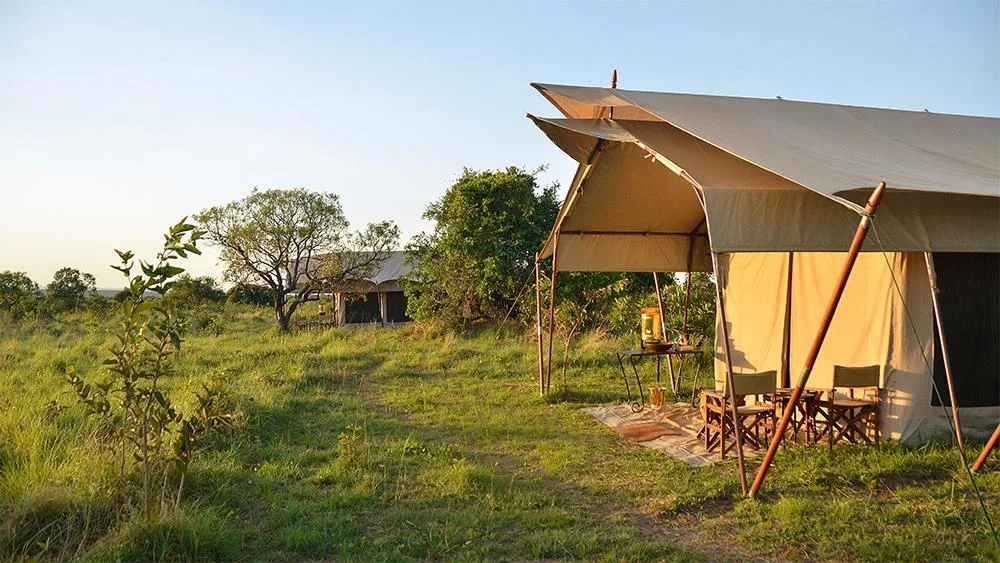
A deluxe tent at the AndBeyond Serengeti Under Canvas camp.
It was on the Serengeti, we witnessed a David and Goliath confrontation, when two female ostriches, standing at six foot, six inches, came under attack from two tiny lapwings. The ostriches had strayed too close to the birds’ ground nest and were in danger of crushing the eggs. Fearlessly, the lapwings dive-bombed their puzzled opponents, both of which finally got the message.
It’s important to remember that a safari is like a tapestry, made up of multiple sightings, big and small. Ignore the small ones at your peril – they add so much charm to the overall experience.
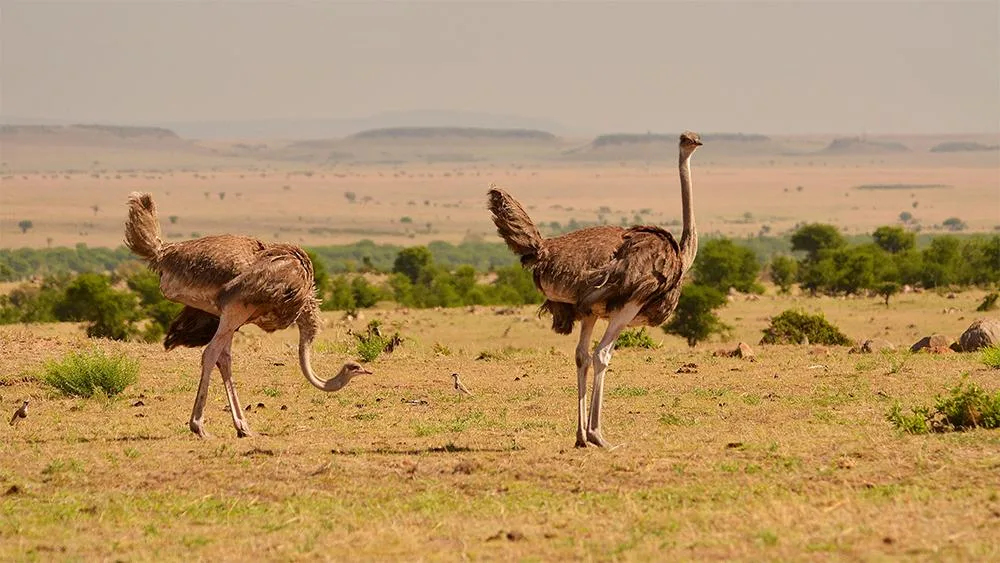
“Pick on someone your own size.” A female ostrich sizes up a lapwing.
Australia is famous for its large salties, but the Serengeti’s River Mara has equally impressive freshwater crocodiles, which feast on wildebeest as they cross the river during the Great Migration. We may have missed the Migration, but we witnessed its aftermath: islands of wildebeest corpses in the river, snagged on boulders and sandbanks.
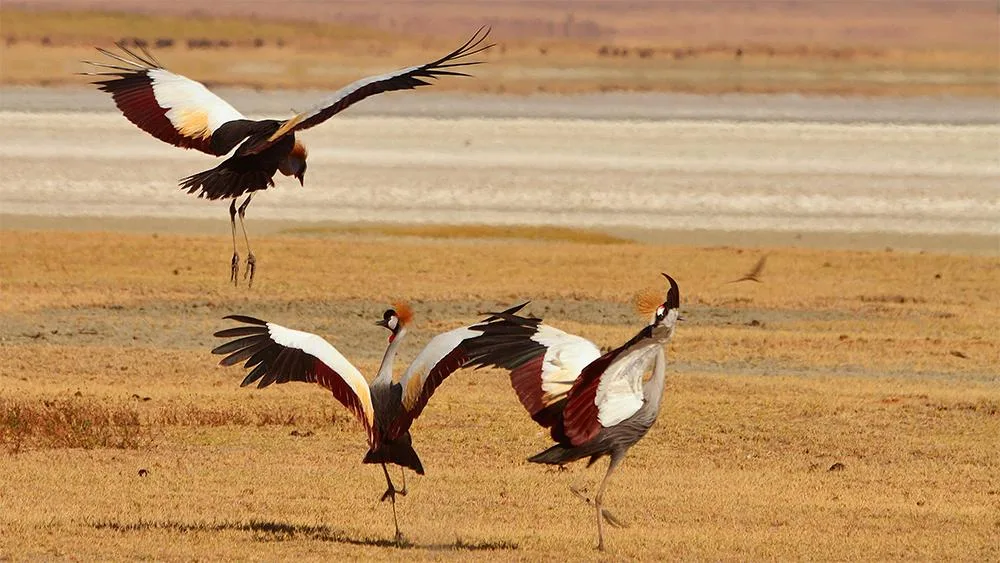
A trio of cranes dance on the Ngorongoro crater floor.
The highlight for many visitors to Tanzania is the old volcano in the Ngorongoro Conservation area. Here, you’ll find the densest concentration of wildlife anywhere on the planet, some 30,000 animals in what amounts to a “lost world”, hovering just under the clouds. On the vast crater floor are several small forests, a soda lake and a vast expanse of savanah, all surrounded by precipitous hills 610 metres high.
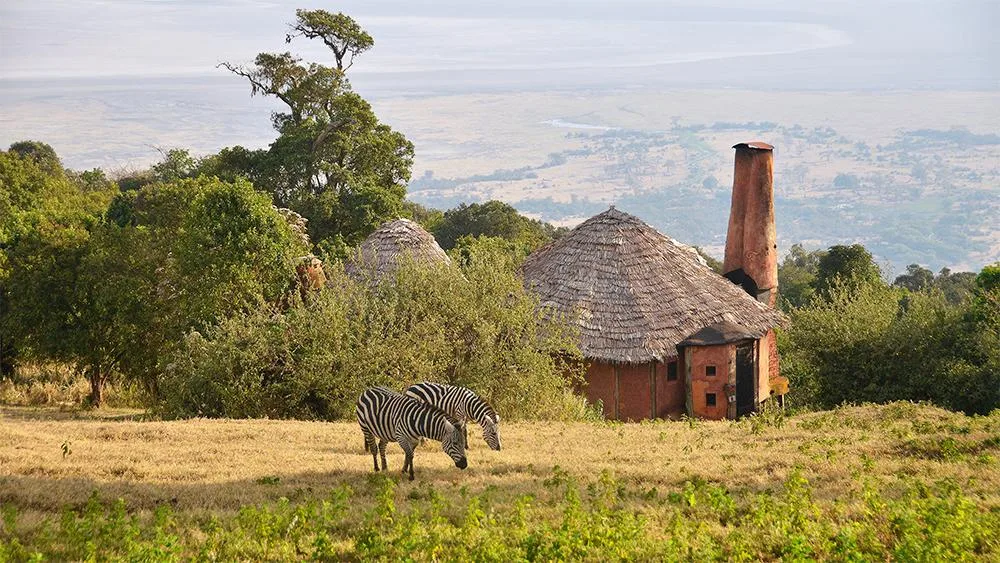
Zebras on the lawn at the AndBeyond Ngorongoro Crater Lodge.
On the crater rim, out of sight, are some of Tanzania’s most exclusive lodges, including the AndBeyond Ngorongoro Crater Lodge, where zebras graze on the lawn. It’s a 20-30 minute drive to the crater floor and from the moment you leave the lodge, the views almost make you light-headed with delight.

“Move over, junior,” a female hippo appears to intimidate a youngster at a wallow.
It’s an ancient landscape, almost biblical, one in which you expect to see Noah’s Ark resting on the lake. Instead, a flock of cranes were dancing – the filaments of their golden crests radiating sunlight like haloes. In the distance were herds of buffalo and several bull elephants, a solitary black rhino and, close to a mud wallow full of hippos, a large male lion with a fine mane was quenching his thirst. A quintessential African scene – one that for me will last a lifetime.
**USEFUL INFORMATION
**
AndBeyond has 33 high-end lodges in seven African and South Asian countries and are known for pioneering a sustainable approach to safaris and supporting local communities close to its lodges.
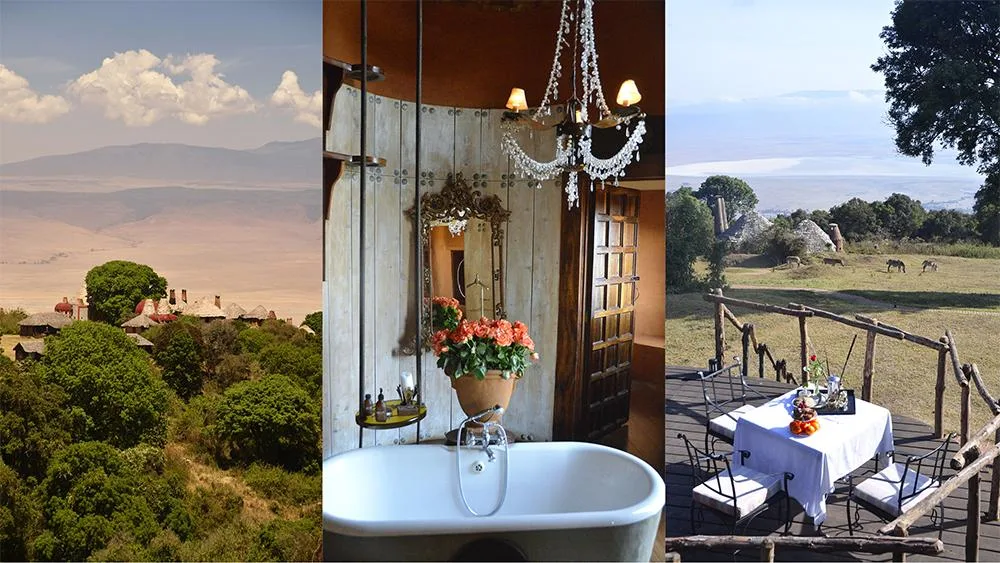
AndBeyond’s Ngorongoro Crater Lodge: The lodge; a bathroom; al fresco breakfast.
Clothes: Wear khaki, beige and white. These colours are least conspicuous to animals. Long sleeves and long trousers give maximum protection against mozzies and other biting insects. Take comfortable light boots. A fleece, sweater or jacket are needed at altitude ie the Ngorongoro Crater.
Equipment: A telephoto lens will deliver the best photos. Binoculars bring the animals to you.
Currency: US dollars are best – small to medium denominations. Tanzanian shillings can only be exchanged on arrival – US$1 = 1600 shillings; AUD$1 =1460 shillings.
Insect repellent: The best is Mosi-Guard. This deters tsetse flies and mozzies. Deet products attract tsetse flies.
Vaccination: Check with a medical specialist. Remember, if you are travelling to Kenya or certain countries in tropical Africa on your way to Tanzania, you will need a yellow fever vaccination. Yellow fever is not mandatory for Tanzania.
Visa: Australians can get visas on arrival for US$50.
Take: Pack on the lighter side if you are flying in small planes between camps.
**BEST TIME TO GO
**
Tanzania offers astonishing diversity – from beach holidays on tropical islands to safaris on the Serengeti, Ngoronogoro crater and at many other national parks, plus adventure challenges, such as climbing Mount Kilimanjaro. For further information and advice, contact African Travel Specialists (1300 761 980), the largest Australian tour operator into East Africa with nearly 50 years’ experience. African Travel Specialists can tailor a safari to suit your needs and budget. They recommend visits:

Can I scratch my head with my toes? A baby baboon stretching.
December to January: The southern part of Serengeti is pumping with millions of wildebeest (as well as predators) – it is when they drop their calves.
July – end of August: The northern part of Serengeti, where the Migration of wildebeest and zebra is crossing the rivers.
Late October to mid-December: Great time to visit the Ngorongoro Crater, but it’s warming up on the Serengeti and at Lake Manyara.
June to late October: The dry season with cool nights, warm to hot days, but take a fleece to the Ngorongoro Crater – you’ll need it after sundown.


